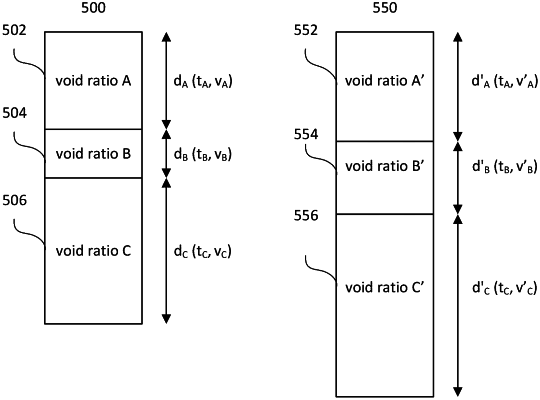| CPC G01V 1/305 (2013.01) [G01N 33/246 (2013.01); G01V 1/306 (2013.01)] | 16 Claims |

|
1. A system for decompacting subsurface data, the system comprising:
an acoustic wave generator/transmitter for sending acoustic waves into a subsurface region, the acoustic waves penetrating into the subsurface region, reflecting off layers within the surface region, and returning for detection;
an acoustic wave detector/receiver for receiving the acoustic waves and measuring travel times of the acoustic waves that reflected off the layers within the subsurface region;
one or more physical processors configured by machine-readable instructions to:
determine void amount of the layers within the subsurface by measuring moisture content within samples extracted from the subsurface region;
determine decompacted void amount of the layers within the subsurface region, the decompacted void amount representing amount of void within the layers without compaction of the layers, wherein the decompacted void amount of the layers is determined based on materials within the layers and/or deposition conditions for the layers;
determine surrogate decompaction velocity for the layers within the subsurface region based on the decompacted void amount of the layers within the subsurface region, the surrogate decompaction velocity including a surrogate velocity used in place of actual or measured velocity of the acoustic waves to artificially expand thickness of the layers within the subsurface region to thickness without compaction, wherein determining the decompaction velocity for the layers within the subsurface region based on the decompacted void amount of the layers within the subsurface region includes:
determining expanded thickness of the layers based on the decompacted void amount of the layers, the expanded thickness of the layer including estimation of the thickness of the layers without compaction via increasing the thickness of the layers in accordance with increase in the amount of void from the measured void amount to the decompacted void amount; and
determining the surrogate decompaction velocity for the layers based on the expanded thickness of the layers and the measured travel times of acoustic waves that reflected off the layers within the subsurface region;
generate a decompacted digital representation of the subsurface region by applying the surrogate decompaction velocity for the layers within the subsurface region to the measured travel times of the acoustic waves that reflected off the layers within the subsurface region, the decompacted digital representation of the subsurface region including artificially expanded thickness of the layers of the subsurface region in image form by applying the surrogate decompaction velocity to the measured travels times of the acoustic waves, wherein the decompacted digital representation of the subsurface region enables indirect measurement of decompacted thickness of the layers within the subsurface region, decompacted depths between acoustic reflectors within the subsurface region, and decompacted positions of subsurface features within the subsurface region; and
perform analysis of past events within the subsurface region based on the decompacted digital representation of the subsurface region, wherein usage of the decompacted digital representation of the subsurface region for the analysis of the past events within the subsurface region provides more accurate analysis of the past events within the subsurface region than usage of a non-decompacted digital representation of the subsurface region.
|